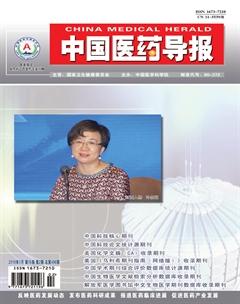利用bFGF提高直接重编程诱导成纤维细胞向心肌细胞转化效率的实验研究
任杰 赵龙 宋振祥 李伟
[摘要] 目的 研究碱性成纤维细胞生长因子(bFGF)对直接重编程细胞向心肌细胞转化的影响。 方法 取大鼠尾成纤维细胞,利用GATA-4、Mef2c、Tbx5三个基因同时转染进行直接重编程。重编程后将细胞随机分为两组,一组正常培养,另一组加入50 μg/L bFGF进行培养。干预2周后,通过检测心肌细胞特异性蛋白如肌钙蛋白T(cTNT)、α-肌球蛋白重链(α-MHC)、GATA结合蛋白4抗体(GATA-4)和连接蛋白43(CX43)的表达及分析细胞电生理特点鉴定细胞分化,并比较两组分化比率。 结果 Western blot和免疫荧光检测结果显示,bFGF明显提高直接重编程细胞内cTNT、α-MHC、GATA-4和CX43的表达(P < 0.01)。电生理分析显示这些细胞与心肌细胞的电生理特点极为相似,进一步证实了心肌细胞转化。 结论 成纤维细胞可以通过直接重编程转化为心肌细胞,bFGF可促进这一过程,这可能成为一种新的获取心肌细胞的方法。
[关键词] 直接重编程;心肌细胞;碱性成纤维细胞生长因子
[中图分类号] R318.11 [文献标识码] A [文章编号] 1673-7210(2019)01(b)-0017-04
[Abstract] Objective To investigate the effects of basic fibroblast growth factor (bFGF) on the transformation of direct reprogramming-induced transdifferentiation of fibroblasts into cardiomyocytes. Methods Direct reprogramming was performed to induce rat tail fibroblasts into cardiomyocytes by defined factors GATA-4, Mef2c and Tbx5. Then the cells were divided into two groups, one group was cultured normally, and the other group was cultured with 50 μg/L bFGF. Two weeks later, the differentiation of cardiomyocytes was identified by detection of the expression of cardiac specific protein such as cardiac troponin T (cTNT), α-myosin heavy chain (α-MHC), GATA binding protein 4 antibody (GATA-4) and connexin 43 (CX43) and analysis of electrophysiology. And the differentiation rates of the two groups were compared. Results Western blot and immunofluorescence test showed that the expression of cTNT, α-MHC, GATA-4 and CX43 significantly up-regulated after exposure to bFGF (P < 0.01). And the further analysis of electrophysiology revealed that the electrophysiological characteristics of these cells were very similar to those of cardiomyocytes, which was identified as cardiac differentiation. Conclusion Fibroblasts can be induced by direct reprogramming to differentiate into cardiomyocytes, which can be promoted by bFGF. This study may provide a new method to harvest cardiomyocytes.
[Key words] Direct reprogramming; Cardiomyocytes; Basic fibroblast growth factor
心肌梗死是冠状动脉粥样硬化性心脏病的严重类型之一,病死率极高,但却无有效的治疗方法。由于自身的心肌细胞再生能力极为微弱,远远不能满足梗死后的心肌组织再生的需要,所以外源性的细胞移植可能是心肌梗死最有希望的治療策略。因而具有心肌细胞分化能力的各种干细胞一跃成为了研究热点。虽然已经证实干细胞移植疗效明确,但因种子细胞治疗有限、获取困难或存在异体移植的伦理问题等,始终无法得到广泛应用。另外,近年来组织工程技术飞速发展,使得人工培育组织工程心脏成为可能,但是同样面临无合适的种子细胞问题。因此,探索一种高效获取心肌细胞的方法是解决这些问题的关键。
干细胞是一类具有分化能力的细胞,能分化为心肌细胞的干细胞有骨髓间充质干细胞、胚胎干细胞、脂肪干细胞以及诱导多能干细胞等[1-2]。但是,数量有限、获取困难或伦理等问题限制了这些细胞的广泛应用。最近该领域取得了突破性进展,Ieda等[3]利用GATA-4、Mef2c和Tbx5(GMT)三个转录因子转染将大鼠成纤维细胞直接诱导转化成为心肌细胞。开拓了一种全新的获取心肌细胞的方法,即直接重编程技术。这种技术可以较为容易地获取大量的心肌细胞,是一种潜力巨大的心肌细胞获取策略。然而,直接重编程的转化效率仅为50%左右,亟待提高。已经证实,碱性成纤维细胞生长因子(bFGF)具有促进干细胞向心肌细胞分化的能力[4-6],推测其亦可能提高直接重编程的心肌细胞转化效率。另外bFGF是一种已经广泛应用于临床的生长因子,其安全性和有效性已被充分证明[7]。本研究拟采用外源性的bFGF干预,观察直接重编程成纤维细胞向心肌细胞转化的过程。
1 材料与方法
1.1 大鼠尾成纤维细胞制备及培养
利用组织干涸法提取SD大鼠(200~250 g)尾成纤维细胞,所有实验用细胞均来自同一只大鼠,购自北京维通利华实验动物技术有限公司,合格证号:SCXK(京)2011-0011,利用成纤维细胞特异性抗原DDR2和Vimentin鉴定。所得的成纤维细胞置于含有10%胎牛血清、100 U/mL的青霉素和链霉素的DMEM/F12培养基中培养(5%CO2、37℃),每周换液2次。当汇合度达90%时传代。
1.2 直接重编程及分组
传至第3代,利用携带GATA-4、Mef2c、Tbx5三种因子的Lipofectamine 2000转染系统体外直接重编程成纤维细胞。重编程后将细胞随机分为未处理组(在培养基中加入与bFGF组等量溶剂)及bFGF处理组(在培养基中加入50 μg/L bFGF)。
1.3 蛋白表达测定
采用Western blot技术测定心肌细胞特异性肌钙蛋白T(cTNT)、α-肌球蛋白重链(α-MHC)、GATA结合蛋白4抗体(GATA-4)和连接蛋白43(CX43)的蛋白表达,内参为甘油醛-3-磷酸脱氢酶(GAPDH)。所有抗体均购于英国Abcam公司。cTNT、α-MHC、GATA-4和CX43均为鉴定心肌细胞转化比率的指标。
1.4 电生理分析
进一步利用膜片钳技术分析诱导心肌细胞的电生理特点。所用设备包括:膜片钳放大器(Axopatch 200B)、数模转换装置(Digidata 1200)、Pclamp 5.5.1和Clampfit软件。采用电流钳制方式记录动作电位时程(action potential duration,APD)、钠电流(sodium current,INa)、L-型钙电流(L-type calcium current,ICa-L)。封接电阻在2 GΩ以上。
1.5 免疫荧光染色
细胞制成爬片,利用免疫荧光染色测定DDR2和Vimentin表达以鉴定成纤维细胞;测定cTNT和α-MHC表达标记心肌细胞。采用荧光显微镜或共聚焦显微镜进行观察。所有一抗均购自英国Abcam公司。
1.6 统计学方法
利用SPSS 13.0统计软件进行分析,数据以均数±标准差(x±s)表示,两两比较采用独立样本t检验。以P < 0.05为差异有统计学意义。
2 结果
2.1 bFGF对直接重编程细胞心肌特异性蛋白表达的影响
免疫荧光染色结果显示,GMT重编程成纤维细胞2周后,(13.3±3.7)%的细胞表达cTNT,(32.4±4.1)%的细胞表达α-MHC;bFGF处理后有(26.9±4.4)%的重编程细胞表达cTNT,(53.6±4.9)%的细胞表达α-MHC,均明显高于未处理的重编程细胞(P < 0.01)。Western blot结果显示,bFGF处理后cTNT、α-MHC、GATA-4和CX43明显高于未处理的重编程细胞(P < 0.01)。
2.2 新生心肌细胞电生理特点
膜片钳记录分析证实这些细胞具有与心肌细胞相似的动作电位和INa及ICa-L,提示这些细胞已转化为成熟的心肌细胞。
3 讨论
最初的细胞重编程技术是将成体细胞去分化,得到诱导多能干细胞,再将其诱导分化为心肌细胞[8-10]。但该技术过程复杂,转化效率低,将严重限制其临床应用[11-12]。最近研究发现,通过某些因子或者物质作用可将分化成熟的细胞直接转化为另一种分化成熟的成体细胞[13]。通过细胞的基因重编程完成这一过程,称之为直接重编程。
与传统的去分化后诱导定向分化相比,这种直接重编程技术具有以下优势:①转化效率较高。有研究报道,直接重编程可将30%~50%的成熟细胞诱导转化为心肌细胞[3];而诱导多能干细胞的心肌细胞转化效率仅为2%[14-15]。②操作简便。GMT重编程仅需一次转染即可实现直接诱导心肌细胞转化,且1周后即可发现心肌细胞特异性蛋白表达;而诱导多能干细胞要经过多个步骤的操作才能诱导心肌细胞分化,并且耗时长,至少要2个月以上。③定向转化明确。利用特定的因子转染后心肌细胞转化明确,未见直接重编程出现其他杂细胞报道[16-18];但是诱导多能干细胞可分化为多种细胞,单一分化诱导极为困难。由于上述优势,直接重编程诱导的心肌细胞具有十分广阔的应用前景,可能是心肌细胞再生治疗和组织工程最有希望的细胞来源。
然而,直接重編程的转化效率仍需提高[19-20]。已证实,bFGF可促进干细胞向心肌细胞分化[4-6]。因此,本研究进一步探讨了其对GMT重编程的作用。Rosenblatt-Velin等[1]报道,敲除bFGF基因后未成熟心肌细胞生长和成熟明显被抑制,心脏发育明显受阻;而成熟心肌细胞无明显变化,提示bFGF是控制心肌细胞发育成熟的重要因子。本研究在转染后立即加入外源性bFGF,结果显示直接重编程细胞后心肌细胞转化效率明显提高,提示bFGF亦可能是控制直接重编程诱导心肌细胞成熟的关键因子。
本研究结果显示,bFGF可提高GMT重编程后心肌细胞特异性蛋白cTNT、α-MHC、GATA-4和CX43的表达,而进一步行电生理分析显示,这些细胞具有与心肌细胞一致的电生理特点。另外,Ieda等[3]利用共聚焦显微镜在GMT重编程细胞中观察到了“钙火花”。这些证据充分证明这种方法可诱导成纤维细胞转化为成熟的心肌细胞,而bFGF能促进转化效率。
本研究利用GMT直接重编程成纤维细胞,可诱导其向心肌细胞转化。提示直接重编程后应用bFGF可促进心肌细胞转化,可能成为一种完善重编程技术的辅助方法。
[参考文献]
[1] Rosenblatt-Velin N,Lepore MG,Cartoni C,et al. FGF-2 controls the differentiation of resident cardiac precursors into functional cardiomyocytes [J]. J Clin Invest,2005,115(7):1724-1733.
[2] Mohamed TM,Stone NR,Berry EC,et al. Chemical Enhancement of in vitro and in vivo Direct Cardiac Reprogramming [J]. Circulation,2017;135(10):978-995.
[3] Ieda M,Fu JD,Delgado-Olguin P,et al. Direct reprogramming of fibroblasts into functional cardiomyocytes by defined factors [J]. Cell,2010,142(3):375-386.
[4] Zhang GW,Gu TX,Guan XY,et al. bFGF binding cardiac extracellular matrix promotes the repair potential of bone marrow mesenchymal stem cells in a rabbit model for acute myocardial infarction [J]. Biomed Mater,2015,10(6):065018.
[5] Zhang YH,Zhang GW,Gu TX,et al. Exogenous basic fibroblast growth factor promotes cardiac stem cell-mediated myocardial regeneration after miniswine acute myocardial infarction [J]. Coron Artery Dis,2011,22(4):279-285.
[6] Zhang GW,Liu XC,Li-Ling J,et al. Mechanisms of the protective effects of BMSCs promoted by TMDR with heparinized bFGF-incorporated stent in pig model of acute myocardial ischemia [J]. J Cell Mol Med,2011,15(5):1075-1086.
[7] Bouma MJ,Iterson MV,Janssen B,et al. Differentiation-Defective Human Induced Pluripotent Stem Cells Reveal Strengths and Limitations of the Teratoma Assay and In Vitro Pluripotency Assays [J]. Stem Cell Reports,2017,8(5):1340-1353.
[8] Passaro F,Testa G,Ambrosone L,et al. Nanotechnology-Based Cardiac Targeting and Direct Cardiac Reprogramming:The Betrothed [J]. Stem Cells Int,2017,2017:4940397.
[9] Kurotsu S,Suzuki T,Ieda M. Direct Reprogramming,Epigenetics,and Cardiac Regeneration [J]. J Card Fail,2017, 23(7):552-557.
[10] Zhou Y,Wang L,Vaseghi HR,et al. Bmi1 Is a Key Epigenetic Barrier to Direct Cardiac Reprogramming [J]. Cell Stem Cell,2016,18(3):382-395.
[11] Kolanowski TJ,Antos CL,Guan K. Making human cardiomyocytes up to date:Derivation,maturation stateand perspectives [J]. Int J Cardiol,2017,241:379-386.
[12] Chan HY,Keung W,Li RA,et al. Morphometric Analysis of Human Embryonic Stem Cell-Derived Ventricular Cardiomyocytes:Determining the Maturation State of a Population by Quantifying Parameters in Individual Cells [J]. Stem Cells Int,2015,2015:586908.
[13] Fu JD,Stone NR,Liu L,et al. Direct reprogramming of human fibroblasts toward a cardiomyocyte-like state [J]. Stem Cell Reports,2013,1(3):235-247.
[14] Nakane T,Masumoto H,Tinney JP,et al. Impact of Cell Composition and Geometry on Human Induced Pluripotent Stem Cells-Derived Engineered Cardiac Tissue [J]. Sci Rep,2017,7:45641.
[15] Wang X,Hodgkinson CP,Lu K,et al. Selenium Augments microRNA Directed Reprogramming of Fibroblasts to Cardiomyocytes via Nanog [J]. Sci Rep,2016,6:23017.
[16] Zhou Y,Alimohamadi S,Wang L,et al. A Loss of Function Screen of Epigenetic Modifiers and Splicing Factors during Early Stage of Cardiac Reprogramming [J]. Stem Cells Int,2018,2018:3814747.
[17] Engel JL,Ardehali R. Direct Cardiac Reprogramming:Progress and Promise [J]. Stem Cells Int,2018,2018:1435746.
[18] Kojima H,Ieda M. Discovery and progress of direct cardiac reprogramming [J]. Cell Mol Life Sci,2017,74(12):2203-2215.
[19] Van Pham P,Vu NB,Nguyen HT,et al. Significant improvement of direct reprogramming efficacy of fibroblasts into progenitor endothelial cells by ETV2 and hypoxia [J]. Stem Cell Res Ther,2016,7(1):104.
[20] Mohamed TM,Stone NR,Berry EC,et al. Chemical Enhancement of In Vitro and In Vivo Direct Cardiac Reprogramming [J]. Circulation,2017,135(10):978-995.
(收稿日期:2018-07-03 本文編辑:罗乔荔)

